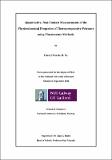Ouantitative, Non-Contact Measurements of the Physicochemical Properties of Thermoresponsive Polymers using Fluorescence Methods.

View/
Date
2011-09-30Author
Morris, Cheryl
Metadata
Show full item recordUsage
This item's downloads: 600 (view details)
Abstract
In biomedical science and engineering the use of microscale thin polymer films is
widespread. These polymer films are often formed on complex geometries which can
provide problems for in-situ analysis and the accurate measurement of multiple
physiochemical properties of thin polymer films is critical in understanding the
polymer function and performance. When undertaking physicochemical
characterisation of thermoresponsive polymers we must consider polymer structure
and also the environment created by a polymer when it is used as a thin film. In
addition, we need to account for the infiltration of solvents and other factors which
may mediate the polymer behaviour. Water uptake in a polymer film can lead to
significant changes in the physiochemical properties. This in turn can affect
mechanical properties and may lead to such problems, in medical devices, as reduced
adhesion, pronounced physical and chemical aging and swelling and expansion,
compromising the intended function of the polymer and hindering biocompatibility.
Thus there is a need for a non-contact, non-destructive method of analysis of these
polymer films. Fluorescence spectroscopy offers a potential non-contact method for
the in-situ analysis of thin polymer films. In this work we demonstrate the use of the
dual-band emission, 3-hydroxyflavone based fluorophores for monitoring the
hydration process in thin (~ 10 m) films of poly(N-isopropylacrylamide)
(PNIPAm), and poly(NIPAM-co-ethylpyrrolidone-methacrylate) (poly(NIPAM-co-
EPM) copolymers. The fluorescence of 3-HF probes is very sensitive to changes in
local polarity and hydrogen bonding. This is observed as shifts and changes in the
relative intensity of the two emission bands (N* and T*), which originate from an
excited state intramolecular proton transfer (ESIPT) process. The spectroscopic
parameters of these probes can thus be correlated with the physiochemical properties
of the probe microenvironment. We incorporated the probes into films of the
thermoresponsive polymers and studied their fluorescence emission behaviour at
different levels of humidity. Analysis of the spectral data showed that with
increasing humidity, the ratio of two emission bands (log(IN*/IT*)), for all
ii
fluorophores increases. Changes were also observed in position of two emission bands;
as humidity increases the N* band shifts to the red with respect to the T* band. It
was also observed that the spectral intensity varied with increasing humidity. When
measurements were made above and below the lower critical solution temperature
(LCST) , it was clear that the films were still absorbing water above the LCST.
Fluorescence measurements also revealed that these probes are also very sensitive to
the subtle differences in copolymer composition as the fraction of EPM is increased.
Results indicate a more equilibrated hydration process with the incorporation of EPM.
Polarity measurements performed (using the solvatochromic Reichardt¿s betaine dye)
revealed that increasing water content in the polymer films resulted in an increase in
polarity (which would be expected due to the highly polar nature of water). However,
little or no variation in band positions or ET(30) parameter indicated that polarity did
not vary with changes in chemical composition, with the exception of PEPm films
where a red shift of the absorption band was noted indicating a decrease in polarity.
However a non-linear response of band position with increasing RH for PEPm
indicated that solvent sorting was taking place.

